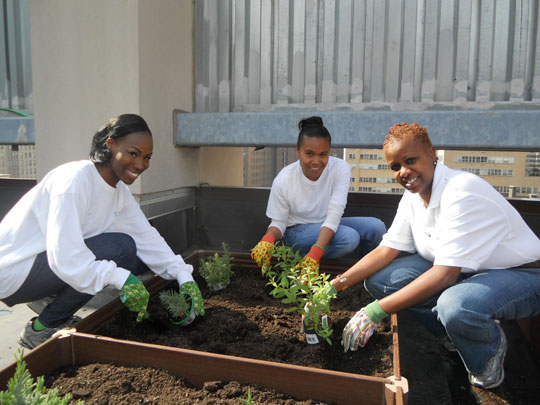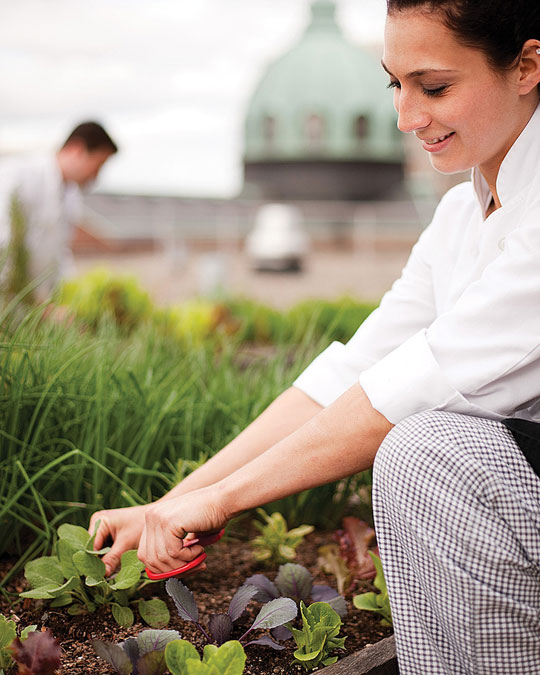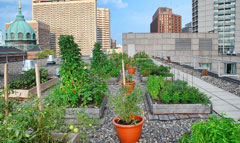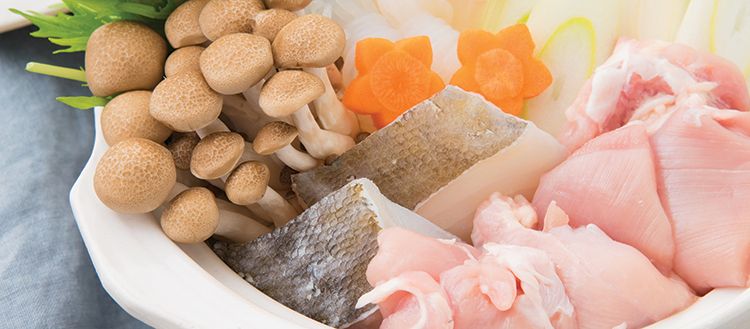Illustration by Faye Rogers.If you’re sitting at the bar at the Sofitel Hotel this summer, you might experience this scenario: After scanning the cocktail menu, you order a mojito, the perfect drink to celebrate a bright afternoon. The first sip is an explosion of flavor—like the rum, lime and mint are dancing a conga line in your mouth. The bartender explains that the mint was picked that very morning from the rooftop garden a dozen floors above your head—about as local as it gets.
Given the many benefits of rooftop gardens (fresh produce, potential lower energy costs and stormwater utility charges among them), it is surprising that not many Philadelphia restaurants are creating them. This may be due to a number of challenges, according to Rania Campbell-Cobb, director of Cloud 9 Rooftop Farm, a local organization that specializes in rooftop agriculture education.
“There are a few standard roadblocks that businesses run into,” she says. “Rooftop gardens can add up to 150 pounds per square foot, which many buildings were not designed to take. They need maintenance and a lot of water, especially if you are growing food, and the space needs to be accessible, secure and have water access.” She adds that many Philadelphia restaurants have smaller roofs, and may decide that it’s not enough space to effectively supply the kitchen.
Thus, it makes sense that these rooftop gardens—Hotel Sofitel, Four Seasons and Square 1682 (adjacent to Hotel Palomar)—are on top of mid-sized hotels, which are well-equipped with the staff, funds and infrastructure necessary to make it work. With the volume of business and corporate ownership, a hotel restaurant may not necessarily be what comes to mind when you envision urban agriculture and farm-to-table cuisine. But these three are bucking that image by growing some of the freshest stuff you’ll find on your plate—or in your martini glass—this summer.
Square1682 at The Palomar Hotel
It’s 10 a.m. and Square 1682’s breakfast service is over. In the short pause before lunch is fully underway, Executive Chef Caitlin Mateo steps out of the kitchen for a breather. She doesn’t go out for a quick walk, or retreat to her office for a few moments of quiet. Instead, she heads up 27 floors to the roof of the Hotel Palomar, the building her restaurant is next to. There, in the cheery morning sun, she snips a handful of herbs, plucks a few heads of Bibb lettuce, and gathers a basket of strawberries.
Last year, Mateo attended a seminar hosted by Philagreen, a hospitality association that introduces restaurateurs, hoteliers and chefs to eco-friendly businesses and products. At the seminar, she was introduced to the concept of an aeroponic garden tower made by a company called Tower Garden, and she instantly wanted one for her restaurant. Mateo says that the main benefits of this style of garden are that it doesn’t need soil, thus eliminating the logistical problem of transporting dirt to the roof, and it has a small spatial footprint. She estimates that it would take 20 to 25 horizontal feet in a traditional garden to yield what the restaurant is growing on their vertical garden.
With the help of the restaurant’s general manager and finance team, Mateo was able to install a nine-foot aeroponic vertical garden system on the hotel’s roof. She gives a lot of credit to the supportive hotel team, as well: “I don’t think if we were just leasing a small space in our location, in Rittenhouse, or in Center City anywhere, that we’d be able to have a garden at all.”
Mateo had some experience with traditional gardens, but said there was a slight learning curve with this style. Aeroponic gardens have no growing medium—the plant’s roots are exposed to the air, and a vitamin-rich water solution cascades over them to provide hydration and nourishment. The pH levels have to be carefully regulated and summer storms could wreak havoc on the tender plants. But Mateo and her team of sous chefs got into a good groove and soon began adding homegrown produce to their menu.
One of Mateo’s favorite dishes that highlighted the rooftop ingredients last summer was a side of Swiss chard with strawberries and Brie. Nasturtiums (edible flowers) became a standard garnish for creamy puréed soups, adding pops of color, and a peppery burst of flavor and crunch. Rooftop herbs, which flourished so well that the restaurant was able to stop ordering commercial varieties, were present in nearly every dish, as well.
The mixologists at the Square 1682 bar were very excited about the fresh herbs at their fingertips. “When we had an abundance of a certain herb, we’d bring them a big bunch, which they’d put on display,” Mateo says. “They’d put the basil right on the bar and it would make the whole bar smell wonderful.” One of the concoctions the bar staff came up with to incorporate the rooftop ingredients was the Blue Sage cocktail, made with fresh sage, tequila, blueberries, pomegranate, coconut sugar and lime juice.
Chef Mateo isn’t sure yet what she’s going to plant this year. Her spring menu, which is still in development, will dictate which ingredients she’ll choose. But one thing is certain: She is sold on the idea of a rooftop garden. “I want to get more vertical gardens up there!” she says. “We really want to use everything we grow and bring it to the customer.”
Liberté Lounge at The Sofitel HotelLiberté Lounge staffers at the Sofitel Hotel plant tomatoes, squash, peppers and herbs.
In April 2013, this Center City hotel unveiled its rooftop garden, Jardin des Fleur de Lis, 15 floors above street level. The concept initially came from a member of the hotel’s sales team, who realized that the flat roof above the hotel would be ideal for growing plants. Management agreed, and large containers of soil were installed, as well as a rainwater conservation barrel. Restaurant staffers pitched in and planted tomatoes, squash, peppers and a bevy of herbs, such as lavender, parsley, basil, tarragon, thyme and sage.
With unblocked access to sunlight and rain, the garden flourished. Inspired by the bounty, Liberté Chef Jim Coleman added a roasted vegetable salad to the menu, a medley of rooftop sweet peppers, zucchini, tomatoes and yellow squash. Pastry Chef Leah Lantieri created decadent little shortbread cookies filled with jam made with rooftop tomatoes, a final treat given to all diners at the Lounge. The bartenders made use of the fresh herbs, creating the Cucumber Sage Collins, a riff on the traditional Tom Collins, which combined Hendrick’s Gin, St. Germain elderflower liqueur, cucumber and lemon with savory fresh sage from the garden.
In addition to the edible perks, the hotel’s General Manager Vincent Vienne says the rooftop garden is a great team-building tool. “Team members from all different departments—not just from the culinary team—are involved with weeding, watering and harvesting the garden,” he says. “It is also a way to educate our team about growing vegetables. Some people have even started their own gardens at home!”
The hotel staff is looking forward to the upcoming season, and may even be installing two beehives to their elevated agricultural area. The addition of an apiary would supply the kitchen and bar with yet another ingredient to sweeten up their French-inspired menu.
The Fountain at The Four Seasons The Four Seasons grows hot peppers, zucchini, spring lettuces, pole beans, French haricot vert, herbs and more on its rooftop garden.
Standing on 18th Street, looking up at the Four Seasons Hotel, you might be surprised to see a few tendrils of green peeking over the swanky hotel’s rooftop. Those raspberry and blueberry bushes are part of the garden that’s been in operation there for the past five years.
The Fountain at the Four Seasons’ Banquet Chef Joe Drago says that chefs in the restaurant’s different culinary wings had been discussing the possibility of a rooftop garden since the late ’90s but cost was the main prohibitive factor. Getting the massive amounts of soil needed to the roof constituted the bulk of the expense, which the hotel management couldn’t justify.
The Four Seasons’ rooftop garden has been in operation for the past five years.It wasn’t until 2009, when another green project—the installation of wind turbines on the roof —presented an opportunity: Because the engineering team already had giant cranes rented to lift the turbines, they agreed to hoist up a few hundred pounds of dirt as well. The horticultural specialists who oversee all the greenery in the hotel planted the first iteration of the garden, and they were off and running.
Members of the kitchen staff now take responsibility for watering, pruning and harvesting the hot peppers, zucchini, spring lettuces, pole beans, French haricot vert, and an aromatic assortment of herbs, including lemon verbena, three types of thyme, Thai basil, bay leaf, mint, sage and rosemary.
Though nearly all of the items grown in their garden can only partially supplement the needs of their busy kitchens, a few crops have been so successful that the chefs have been able to drastically reduce their normal orders during the warmer months.
“Throughout the summer, we order maybe four to six pounds of basil every day,” Drago says. “So, if we can supplement that from the roof—if we can cut two pounds a day—it does save some money.”
The Four Seasons kitchens don’t need to buy commercially grown thyme and rosemary for more than half of the year, and the same goes for hot peppers. But not everything has been fruitful—the berry bushes don’t really yield enough to be featured in dishes, and a lemon tree planted last year only grew six lemons. Nevertheless, Drago says that they like to experiment and have fun with what they try each season.
This June, the rooftop produce will start making appearances in food specials and cocktails. Last year at the Fountain at the Four Seasons restaurant, an herb-roasted guinea hen duo accented with rooftop marjoram was a frequent dinner special, and house-made potato gnocchi topped with rooftop chives was on at lunch. Refreshing rooftop rosemary limeade was a hit at the Lounge bar, and a rooftop mint chip ice-cream sandwich cooled down customers. For the many wedding receptions held in the hotel through the spring and summer, couples could create signature cocktails using rooftop herbs of their choice, and the banquet menu included dishes enhanced by the herbs as well, like the Block Island swordfish with rooftop lemon thyme, cipollini onions and aged balsamic jus.
Drago says it’s a chef’s dream to be able to work with such fresh ingredients. “Anything you pull right out of the ground, the flavor is so much more intense,” he says. “Even though we get food orders in every day, it’s cool to cook with something that you grow with your own hands.”
Story byEmily Kovach.














What a great program!